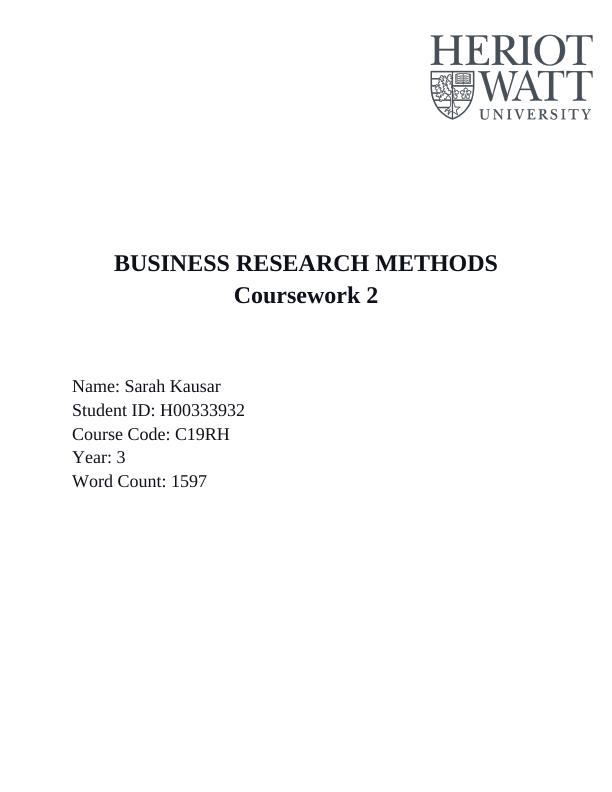Ask a question from expert
Business Research Methods Assignment
12 Pages4008 Words104 Views
Added on 2021-03-01
Business Research Methods Assignment
Added on 2021-03-01
BookmarkShareRelated Documents
BUSINESS RESEARCH METHODSCoursework 2Name: Sarah KausarStudent ID: H00333932Course Code: C19RHYear: 3Word Count: 1597

A STUDY OF CONSUMER SATISFACTION IN THE USEOF PEER TO PEER LENDING SERVICES IN DUBAI’SFINTECH INDUSTRYIntroductionWith the emergence of advanced technologies in the financial services sector, peer-to-peerlending services are gaining traction and proving to be good alternatives to conventional bankfunding in Dubai. This research further aims to analyze and explore consumer satisfaction in theuse of peer-to-peer lending services in Dubai using a suitable methodology.Research PhilosophyA philosophical paradigm can be defined as a set of beliefs, experiences, assumptions and valuesthat influence the perceptions of reality by an individual and their responses to theseperceptions(Kuhn,1970). Philosophical paradigms raise three fundamental questions; ontologicalquestions; which question the nature of reality, epistemological questions; which question whatconstitutes knowledge, and methodological questions; which are concerned with the philosophiesthat guide data gathering methods which in turn can be used by the researcher to ensure validresults from the research(Guba and Lincoln, 1994). The paradigm selected guides the researcherregarding philosophical assumptions and the selection of methods, tools and instrumentsregarding the object of study(Denzin, 2000; Ponterotto, 2005). Crotty(1998) describes ontology as the “study of being”(Crotty, 1989). Further, Ontology can beviewed either objectively or subjectively(Saunders, Lewis and Thornhill, 2016). Epistemology isconcerned with the creation of knowledge, how it can be obtained and communicated(Scotland,2012). It is used to establish a relationship between the knower and what is known, and to1

interpret the nature of such a relationship(Krauss, 2005). Positivism and interpretivism can bespecified as the two main aspects of epistemology(Krauss, 2005). Positivism posits the beliefthat social reality can be studied scientifically and systematically to produce law-likegeneralisations(Saunders, Lewis and Thornhill, 2016). Accordingly, the focus of a positivistresearch is to yield purely objective and quantitative data and findings which are not influencedby human interpretation and bias(Krauss, 2005). The positivist paradigm further elucidates thatthe researcher is detached and independent of the object of research, as a result of maintainingminimal interaction with the participants(Krauss, 2005). In contrast, interpretivism examines theindividual interpretations and perceptions that people have about their socialbehaviours(Halstead, 2002). The primary focus of an interpretivist is to gain an insight into theunique experiences of individuals and groups within different contexts, rather than viewingsociety through an objective lens(Collis and Hussey, 2014). Since this research proposal aims to study consumer satisfaction in the use of peer-to-peerlending services in the Fintech sector in Dubai, a large sample size is required to represent thechosen group in order to provide generalized, measurable and quantifiable results and facts.Therefore, the research proposal will use the objective and deductive approach of positivism.Data Collection MethodsThere are two commonly used methods used for the collection of data; quantitative methods areapplied to research questions requiring numerical data, whereas qualitative methods are appliedto research questions requiring textual data(Williams, 2011).According to Creswell (2002), quantitative research is “the process of collecting, analyzing,interpreting, and writing the results of a study”. Data collected through quantitative methodsrequire a large sample size and is generally precise as it employs mathematical models, theoriesand deductive processes pertaining to natural phenomena(Onwuegbuzie and Leech, 2005). Asopposed to quantitative methodologies, which are based on numbers and positivistclaims(Schrag, 1992), qualitative research relies primarily on words and the quality of activities,situations or materials(Patton, 2015). Some examples of qualitative research include interviews2

and focus groups(Paradis et al., 2016). As this research will be rooted in the positivist paradigmand in order to gain an understanding of consumer satisfaction levels, quantitative methods willbe used to collect data(Schrag, 1992).Examples of quantitative research methods include surveys, correlational research andexperimental research(Apuke, 2017). For the purpose of gathering data that can be tested usingstatistical methods, a survey will be used(Bowling and Ebrahim, 2010). Surveys enable datacollection through paper-and-pencil questionnaires, telephone or face to face interviews. Onlinesurveys are the most preferable as not only are they flexible(Lindsay, 2005) but are also cost-effective and provide convenience in several ways(Evans and Mathur, 2005). For the targetpopulation, participants will be required to have experience of either borrowing or investingfunds in peer-to-peer lending companies. After gathering user data, they will be sent a surveyquestionnaire either through email or text. The survey will be divided into two parts, with thefirst part consisting of 3-4 questions focusing on the respondents' demographics(age, gender,occupation and level of education), followed by the second part consisting of 9-10 close-endedquestions regarding attitudes, perceived ease of use and usefulness, and a final question onoverall satisfaction in the peer-to-peer lending services. A minimum of 100 participants will besurveyed to generate meaningful and statistically significant results(Martínez-Mesa et al., 2014).The participants will respond on a 5-point Likert scale survey, with points ranging from‘strongly agree’ to ‘strongly disagree’(Croasmun and Lee, 2011). A 5-point Likert scale ispreferred as it is less confusing and increases response rates, as compared to otherscales(Danaher and Haddrell, 1996). The Likert Scale will be used due to its ease of use andconvenience for the participants(Shaw and Wright, 1967).While designing the survey, it will be kept in mind to phrase the questions as briefly, clearly andspecifically as possible(Lindsay, 2005). This is necessary as lengthy or ambiguous questionsmight lead to vague replies from the participants(Lindsay, 2005). However, quantitative research is faced with several limitations, which include the inability tocontrol the environment, difficulty in data analysis and limited outcomes(Baxter and Jack, 2008).Further, surveys have been criticized for their lack of depth and low response rates(Coughlan,3

End of preview
Want to access all the pages? Upload your documents or become a member.
Related Documents
Use of Artificial Intelligence - PDFlg...
|10
|3700
|263
Value Chain of Strategy in Taiwan Techlg...
|10
|4074
|117
Research Methodology: A Comprehensive Guidelg...
|42
|10829
|350
Research Methodologylg...
|11
|3049
|149
Justification for Using Qualitative Approachlg...
|18
|5149
|2859
The Notion of Quantitative and Qualitative Divide in the Social Sciencelg...
|6
|1592
|83